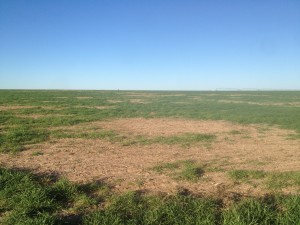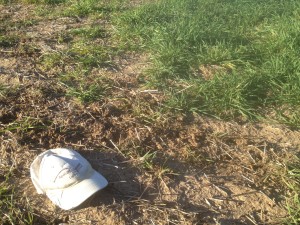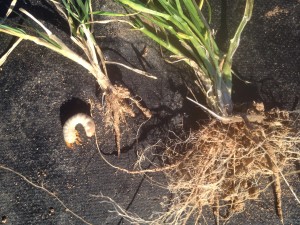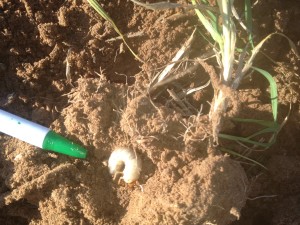by Dr. Calvin Trostle, Extension Agronomy, Lubbock, 806-746-6101, ctrostle@ag.tamu.edu
Throughout the Texas High Plains and the Rolling Plains and beyond from about late September to the end of November this question is asked every year. AgriLife Extension entomologists and agronomists working with wheat and other small grain have gotten so used to this annual question we have to be careful to not assume the cause. Our questions will be:
• “Are the spots getting larger? (Yes)
• Is the field in continuous wheat? (Yes)
White grub worms, most often of May or June beetles (the larval stage of the June bug),are the culprit. Due to lack of rotation or any cultural practices like lack of tillage or failure to control weeds (which provide the grubs an ongoing food source outside the season of wheat growth), grub worms move through their lifecycle. Wheat and other small grains planted into fields with continuous small grain typically show many dead spots, and they are getting larger (Fig. 1).

Fig. 1. Spreading grub worm damage across a Dawson Co., TX wheat field planted in early September, 2015. Bare spots continue to expand as of early November. About 10% of the field is currently damaged.
In two instances this fall based on phone discussions I thought maybe grubs were actually not the problem. No, the farmer just had to look more and dig a little deeper in the soil. Typically I like to dig plants in the “transition zone” between bare spots, then dying or poor plants, and what looks like normal, healthy wheat (Fig. 2). That is where you will most likely find the worms. Later in the season after significant cooling you may need to dig deeper, but it is not uncommon to turn up at least 1 grub per shovel full of soil in the transition zone.

Fig. 2. The “transition zone” where grub worms are most active. Most wheat to the left and center-bottom is dead due to root system eaten off. Transition is above and to the right of the hat with normal wheat (at least no evidence yet of feeding) the upper right.
The worst damage—a dead plant—occurs when a grub is feeding near the wheat seeding depth and severs the root system right below the crown. This seedling is left with no root and will die. If grubs feed a little lower on the root system, the plant will be small and its productivity much reduced (Fig. 3). This plant will have much less root than a normal plant (Fig. 4), but it is often enough to sustain it until cooler weather when the grubs move further down in the soil.

Fig. 4. Comparison of wheat seedling root that has lost most of its root system (left) due to grub feeding vs. a normal, healthy root system (right). The seedling on the left may still survive, but it will be stunted and exhibit poor growth for some time resulting in greatly reduced forage potential or a reduction in tillering and potential grain yield.
You can read more about grub management in wheat on pages 3, 5, and 6 in Texas A&M AgriLife Extension’s “Managing Insect and Mite Pests of Texas Small Grains,” E-399 (2012) (pages 3, 5-6) at http://www.texasinsects.org/small-grains.html White grubs are also often a problem in turfgrass, and additional information about adult/larval insect biology is found in Texas A&M AgriLife’s “White Grubs in Texas Turfgrass,” E-211 (2011) at http://extentopubs.tamu.edu/e-211.html
If I have white grubs in my wheat can they be controlled?
No. Once the wheat is planted you can’t get at the grubs. Though chemigation of Lorsban (chlorpyriphos) has been discussed by some, it is not labeled in wheat. (Occasionally ask your entomologist if there are any new options.) Often I recommend that growers wait until cold weather sets in, which means the grubs move further down in the soil, then re-seed your wheat in the blank spots.
What should I do if I anticipate grubs will be a problem in my next crop?
Here are some considerations:
• Remember that rotation with a non-host crop does help. This may be necessary though it is difficult for those in small grains grazing programs to rotate out regularly.
• The above wheat insect guide notes that Gaucho (imadacloprid) and Cruiser (thiamethoxam) seed treatments might be effective. Remember, though, that grub worms can be large (0.5” or more), and these are more difficult to control.
• Control weeds to eliminate potential food sources for grubs during the off-season.
• Delayed planting may reduce the chance grubs will completely kill early seedings. This may not be an option in a grazing system, but if even some of your seedings can be delayed that may help.
For further information on grub worms in wheat and other small grains, and additional possible strategies for control visit with your area integrated pest management (IPM) Extension agent or your regional extension entomologist.
